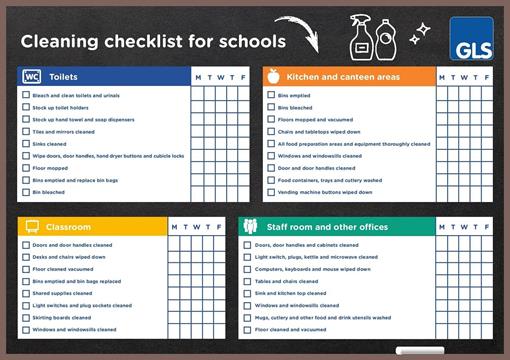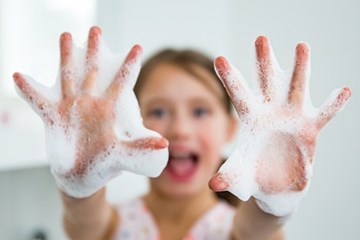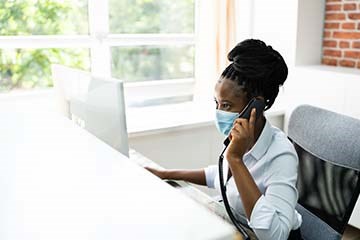Cleaning in schools: A daily, deep clean checklist

Cleaning and general hygiene has always been an important part of a school’s routine and upkeep, but in the age of pandemics, its importance has risen to new heights. Today, it’s the responsibility of everyone to stay on top of cleaning duties, not just your cleaning staff.
To stop the spread of viruses and keep everyone a little happier and safer in school, a daily cleaning schedule and deep clean checklist are essential. In this post we’ll list every aspect of good cleaning habits in schools. Plus, download our free cleaning daily checklist so your school cleans like an efficient, well-oiled machine.
School cleaning checklist
Classrooms
Children and teachers spend a lot of time together in classrooms. These indoor spaces can be a breeding ground for transmission of germs. Giving them a good daily clean should be high on your priority list.
- Clean all doors and door handles
- Wipe down desks and chairs
- Clean and vacuum the floor (mopped if a hard floor)
- Empty bins and replace bin bags. Bleach bin periodically
- Clean any shared supplies (like stationery or art supplies)
- Clean light switches and any other plug sockets
- Clean skirting boards
- Clean windows and windowsills
Toilets
It goes without saying that toilets and bathrooms are a hotspot for germs to spread and transfer from one person to another. A stringent cleaning process is absolutely necessary in these areas of every school. As is the best in personal hygiene habits, something you can help create with our blog on encouraging pupils to wash their hands.
- Bleach and clean all toilets and urinals
- Ensure toilet holders are well stocked
- Fill up hand towel and soap dispensers
- Clean tiles and mirrors
- Clean and wipe sinks
- Wipe doors, door handles, hand dryer buttons and cubicle locks
- Mop floor
- Empty bins and replace bin bags. Bleach bin periodically
Staff room and other offices
Staff members should be well onboard with all the school’s endeavours to stay clean and hygienic, so hopefully your staff rooms and offices shouldn’t need too much regular attention. Still, these areas will need a once over.
- Doors, door handles and cabinets cleaned
- Light switch, plugs, kettle and microwave cleaned
- Computers, keyboards and mouse wiped down
- Tables and chairs cleaned
- Sink and kitchen top cleaned
- Windows and windowsills cleaned
- Mugs, cutlery and other food and drink utensils washed
- Floor cleaned and vacuumed (mopped if hard floor)
Hallways, entrances and the hall/gym
These types of areas are your biggest footfall zones, with many visitors coming from outside the school adding to the crowds in these areas. Your main hall/gym are also a potential hotbed for germ spreading, making these areas some of the most important areas for your cleaning schedule.
- Floor mopped and vacuumed
- Door and door handles cleaned
- Windows and windowsills cleaned
- Benches or other seating areas wiped down
- Sports equipment sanitised after use
- Changing rooms thoroughly cleaned
Kitchen and canteen areas
Wherever food and beverages are being handled, germs can easily spread. With the right buy in from those in school, hopefully these areas can be kept clean – but you’ll still need to get in there with sprays and buckets handy.
- Bins emptied and occasionally bleached
- Floors mopped and vacuumed
- Chairs and tabletops wiped down
- All food preparation areas and equipment thoroughly cleaned
- Windows and windowsills cleaned
- Door and door handles cleaned
- Food containers, trays and cutlery washed
- Vending machine buttons wiped down
The key daily focus areas
Central to any effective cleaning routine is a focus on surfaces that we regularly encounter. If you find your cleaning resources are stretched thin and only have time to do a quick once over, focus on anything you think lots of people will be touching, or breathing on, the next day. Examples include:
- Door handles and doors
- Desks
- Windowsills
- Stationery
- Light switches
- Chairs
Think beyond what we touch directly too. We all touch our shoes every morning to put them on, passing germs onto them. That can then be transferred to school carpets and hard floors and picked up by someone else walking on them. In turn, they then touch their shoes and transfer germs onto other surfaces.
As a result, floors in heavy football areas like hallways, entrance areas and assembly halls should be prioritised for a daily clean.
How often should I clean the school?
Resources are stretched thin across most schools, and sometimes it can be easy to dimmish the importance of cleaning (especially when we reach a post-Covid world). Schools should be cleaning every day, but we know how difficult it is to dedicate the time required. So, focus on the essential areas we detailed above, limiting the transfer of germs each day.
For everything else, set out a weekly rotation so nothing goes too long without a deep clean.
What will I need?
A good strong cleaning regime can only be maintained with the right supplies. Take a glance at your cleaning cupboard – does it have everything on this (far from exhaustative list?
- Toilet tissue
- Hand towels
- Hand sanitiser
- Hand soaps
- Disinfectant
- Blue roll
- Air freshener
- Floor cleaner
- Brushes and brooms
- Mop and bucket
- Multi-purpose cleaner
- Carpet cleaner
- Window and glass cleaner
- Wet wipes
- Washing up liquid
- Refuse sacks
Surface cleaners and sprays can come with lots of science jargon that can leave you baffled as to what is needed in your school. Check out our handy guide to antimicrobials for more information.
Other best practice cleaning tips
- Hygiene in school is everyone’s business: With so many people trudging through your school each day, there is only so much the cleaning team can do. Encouraging best practice from everyone can be a huge help too. Simple things like cleaning up after yourself and washing your hands when you’ve been to the loo may seem small but can make all the difference.
- Don’t be shy with sanitisation stations: You can make it easier for your staff and pupils to follow best hygiene practices by installing cleaning stations around the school. Canteens, corridors and classrooms are ideal locations for a cleaning station filled with hand towels and sanitiser.
- Use signage for safety and reminders: Another way you can encourage cleanliness is with signage and posters. Quick reminders to wash our hands or take our rubbish away with us makes a cleaner and tidier environment for us all.
- Remember the importance of cleaning: If the pandemic has reminded us of one thing, it’s that hygiene is of the upmost importance is an environment like a school. Remind yourself, and everyone around you, that slacking on this important issue can have very negative consequences for everyone connected with the school.
Download our free school cleaning checklist
Keeping up with what has and hasn’t been done every week, plus keeping on top of supplies, can be a nightmare with everything else you have to think about. To help you and the cleaning staff maintain a clean and safe school, download our free deep clean checklist and fill it in as you go.





